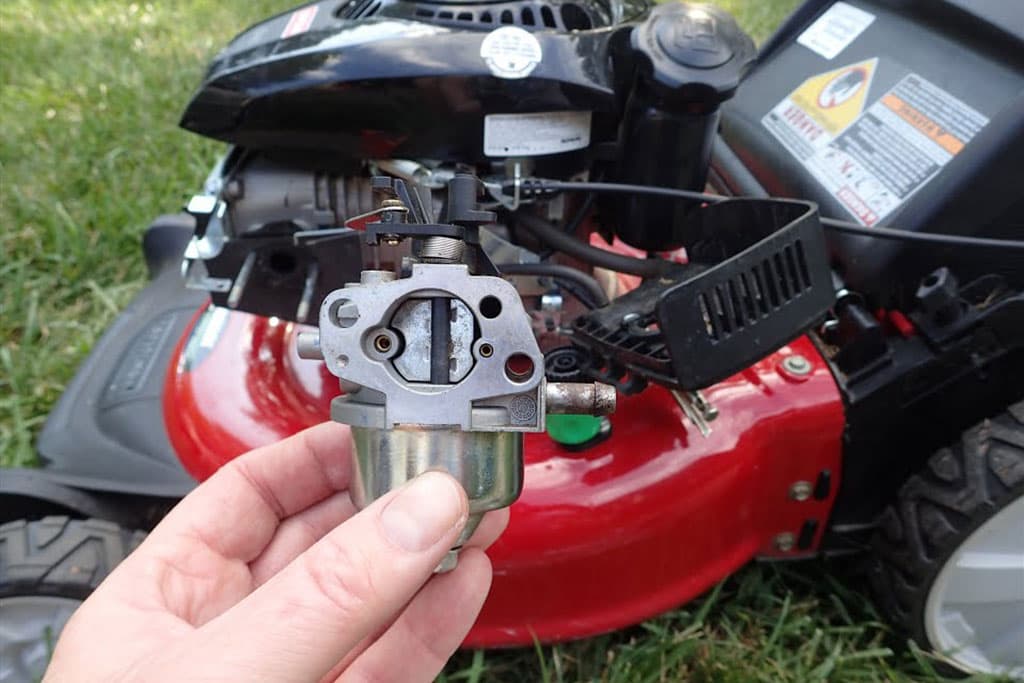Learn the important steps for maintaining your lawn mower’s performance with our guide on how to clean carburetor on a lawn mower. Learn expert tips and easy-to-follow instructions to ensure your mower operates smoothly, keeping your lawn pristine throughout the seasons.
How do you clean a carburetor on a lawn mower without removing it?
Cleaning a carburetor on a lawn mower without removing it is a practical approach to maintaining your mower’s efficiency. Here are the great methods to avail this:
- Safety First: Ensure the lawn mower is turned off, and the ignition key is removed. It’s also wise to disconnect the spark plug wire to prevent accidental starts.
- Access the Carburetor: Locate the carburetor, usually found near the air filter. Remove the air filter housing to gain better access to the carburetor’s exterior.
- Clean the Exterior: Use a brush or cloth to clean dirt and debris from the carburetor’s exterior. This step prevents contaminants from entering the carburetor during the cleaning process.
- Use Carburetor Cleaner: Spray carburetor cleaner directly onto the exterior and inside the air intake while the engine is off. Be generous but avoid oversaturating electrical parts.
- Start the Engine: After allowing the cleaner to work for a few minutes, reconnect the spark plug wire, and start the engine. Let it run for a few minutes. The engine’s operation will pull the cleaner through the carburetor, helping to clear out deposits.
- Repeat if Necessary: If the mower still runs roughly, repeat the process. Sometimes, a second application is needed for tough deposits.
- Reassemble and Test: Once completed, reattach the air filter and housing. Run the mower to ensure it operates smoothly.
How do I know that my lawn mower carburetor is clogged?
If you’re experiencing issues with your lawn mower’s performance, a clogged carburetor could be the culprit. Here’s how to diagnose the problem:
- Difficulty Starting: If your lawn mower struggles to start or requires multiple attempts, it could indicate a clogged carburetor. A blockage prevents the proper mixture of air and fuel from reaching the engine.
- Engine Stalling: If your mower runs for a brief period and then stalls, it might be due to a lack of fuel reaching the engine caused by carburetor blockage.
- Uneven Performance: Noticeable fluctuations in engine speed or power output while mowing could also point to a clogged carburetor. This can lead to uneven cutting or a rough-running engine.
- Black Smoke: Excessive black smoke coming from the exhaust indicates an overly rich fuel mixture, often caused by a clogged carburetor.
- Inspect the Carburetor: Remove the air filter and visually inspect the carburetor for any signs of blockage or dirt accumulation.
Can you clean a carburetor without removing it?
Yes, you can clean a carburetor without removing it, although this method might not be as thorough as taking it out and disassembling it. Here’s a complete guide of how to achieve this:
Firstly, ensure the engine is cool to avoid any accidents. Then, locate the carburetor – it’s typically found near the engine’s air intake. Before proceeding, it’s wise to disconnect the battery to prevent any electrical mishaps.
Begin the cleaning process by removing the air filter to access the carburetor more easily. This is crucial for both safety and efficacy. Once you’ve gained access, use a carburetor cleaner spray, available at most auto parts stores. Spray liberally inside the carburetor while opening and closing the throttle to allow the cleaner to reach different areas inside the carburetor. This helps in dissolving gunk and deposits that can hinder performance.
After spraying, let it sit for a few minutes to break down the deposits. Then, start the engine to allow the cleaner to work through the system. It might run rough initially as it cleans, but it should stabilize.
Remember, while this method helps in improving performance and solving minor issues, it might not be effective for severely clogged carburetors. In such cases, a thorough disassembly and cleaning, or professional service, might be necessary. Regular maintenance is key to preventing carburetor issues and ensuring your engine runs smoothly.
What is the fastest way to clean a carburetor?
Cleaning a carburetor efficiently requires precision and the right approach. The fastest way to clean a carburetor involves several steps. First, remove the carburetor from the engine. Next, disassemble it carefully, noting the position of each part. Utilize a carburetor cleaner spray to thoroughly clean all the components, paying close attention to clogged jets and passages. A small brush or a toothbrush can be handy for stubborn grime. After giving the pieces a thorough rinse with clean water, let them air dry. Once dry, reassemble the carburetor, ensuring all parts are properly aligned. Finally, reinstall the carburetor onto the engine and test its performance.
For expedited results, consider using an ultrasonic cleaner specifically designed for carburetors. These cleaners utilize high-frequency sound waves to dislodge dirt and debris from intricate parts quickly and effectively. Additionally, using compressed air to blow out any remaining debris can aid in achieving a thorough cleaning in a shorter time frame. Always follow manufacturer instructions and safety precautions when cleaning carburetors.
What solution do you use to clean a carburetor?
Cleaning a carburetor is crucial for maintaining optimal engine performance in vehicles or machinery. One effective solution for this task involves using a carburetor cleaner. Begin by disconnecting the carburetor from the engine and removing any attached components. Next, soak the carburetor in a container filled with carburetor cleaner, ensuring that all parts are completely submerged. Allow it to soak for the recommended duration specified on the cleaner’s instructions, typically around 30 minutes to an hour.
After soaking, use a small brush to gently scrub away any stubborn deposits or grime from the carburetor’s surfaces. Pay special attention to the jets, passages, and throttle plates. Once thoroughly cleaned, rinse the carburetor with clean water to remove any remaining cleaner residue.
Finally, allow the carburetor to air dry completely before reassembling it and reinstalling it back onto the engine. Regular cleaning using a carburetor cleaner can help improve fuel efficiency, throttle response, and overall engine performance, ensuring smooth operation and longevity of your equipment. Always follow the specific instructions provided by the manufacturer of the carburetor cleaner for best results.
How do you unclog a carburetor?
Unclogging a carburetor requires some basic tools and a systematic approach. Here’s a simple guide:
- Safety First: Ensure the engine is off and cool before starting any work. Moreover, operate in a place with good ventilation to prevent fume inhaling.
- Locate the Carburetor: It’s typically situated near the engine and connected to the air filter. If you are in doubt, consult your owner’s first.
- Remove the Carburetor: Disconnect the fuel line and any other attachments. Use a wrench or screwdriver to remove the carburetor from the engine.
- Inspect and Clean: Check for any visible debris or buildup in the carburetor’s components. Use a carburetor cleaner and a soft brush to gently remove any dirt or grime.
- Check the Jets and Passages: Ensure that the jets and passages are clear of any obstruction. Use a thin wire or a carburetor cleaning tool to poke through and clean them.
- Reassemble and Test: Put the carburetor back together in the reverse order of disassembly. Reconnect the fuel line and start the engine to ensure proper functioning.

